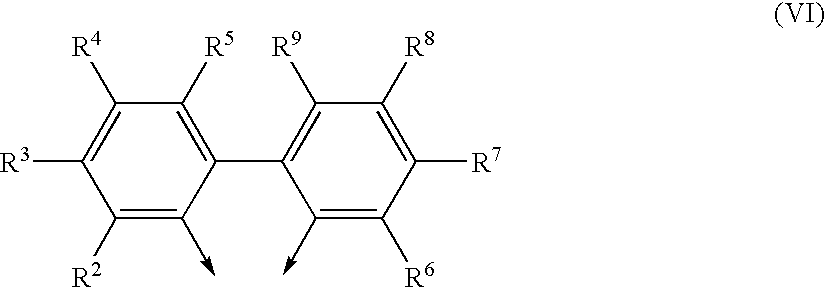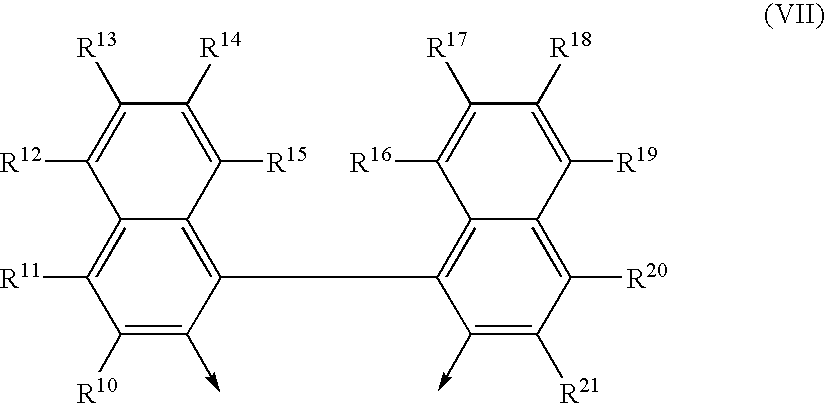Process for preparing phosphites and transition metal complexes
- Summary
- Abstract
- Description
- Claims
- Application Information
AI Technical Summary
Benefits of technology
Problems solved by technology
Method used
Image
Examples
example 1
Preparation of isopropyl dichlorophosphite
[0194]A baked-out three-necked flask equipped with a fitted dropping funnel and distillation attachment and Vigreux column is initially charged with phosphorus tri-chloride (30 ml, 0.34 mol) at −10° C. and 2-propanol (17.5 ml, 0.23 mol) is added slowly via the dropping funnel with constant stirring. After the end of the addition, the mixture is stirred for a further 1 h. Subsequently, isopropyl dichlorophosphite is obtained at 25 mbar (b.p.25:31° C.). In this way, 14.0 g (52% of theory) are obtained.
example 2
Preparation of ((R)-1,1′-binaphthyl-2,2′-diyl)isopropyl phosphite
[0195]A baked-out 100 ml Schlenk flask is initially charged with 75 ml of dried, degassed tetrahydrofuran and 2.41 g (15.0 mmol) of isopropyl dichlorophosphite under argon atmosphere at room temperature and cooled to 0° C. The mixture is admixed with 4.19 ml (30.1 mmol) of abs. triethylamine and stirred for 5 min. Afterwards, 4.28 g (15.0 mmol) of (R)-1,1′-binaphthyl-2,2′-diol are added as a solid. After stirring for a further 15 min., the ice bath is removed and the mixture stirred at room temperature overnight. The solids are filtered off from the reaction solution under protective gas and the solvent is removed under reduced pressure. 4.4 g (79% of theory) of ((R)-1,1′-binaphthyl-2,2′-diyl)isopropyl phosphite are obtained. 31P NMR (162 MHz, CD2Cl2): δ=147.1 ppm.
example 3
Preparation of ((R)-1,1′-binaphthyl-2,2′-diyl)benzyl phosphite
[0196]A baked-out 250 ml Schlenk flask is initially charged with 100 ml of dried, degassed tetrahydrofuran and 2.5 ml (13.6 mmol) of benzyl dichlorophosphite under argon atmosphere at room temperature and cooled to 0° C. The mixture is admixed with 3.82 ml (27.4 mmol) of abs. triethylamine and stirred for 5 min. Afterwards, 3.90 g (13.6 mmol) of (R)-1,1′-binaphthyl-2,2′-diol is added as a solid. After stirring for a further 15 min., the ice bath is removed and the mixture stirred at room temperature overnight. The solids are filtered off from the reaction solution under protective gas and the solvent is removed under reduced pressure. 3.7 g (73% of theory) of ((R)-1,1′-binaphthyl-2,2′-diyl)benzyl phosphite are obtained. 31P NMR (162 MHz, CD2Cl2): δ=140.7 ppm.
PUM
| Property | Measurement | Unit |
|---|---|---|
| Pressure | aaaaa | aaaaa |
Abstract
Description
Claims
Application Information
 Login to View More
Login to View More - R&D
- Intellectual Property
- Life Sciences
- Materials
- Tech Scout
- Unparalleled Data Quality
- Higher Quality Content
- 60% Fewer Hallucinations
Browse by: Latest US Patents, China's latest patents, Technical Efficacy Thesaurus, Application Domain, Technology Topic, Popular Technical Reports.
© 2025 PatSnap. All rights reserved.Legal|Privacy policy|Modern Slavery Act Transparency Statement|Sitemap|About US| Contact US: help@patsnap.com



